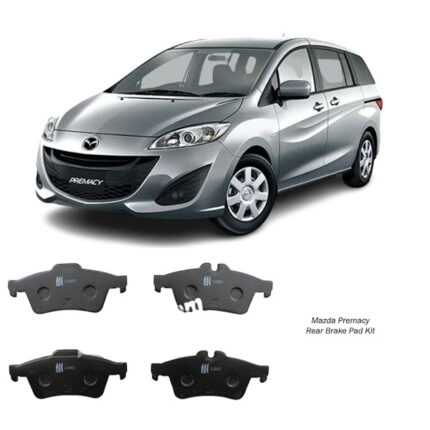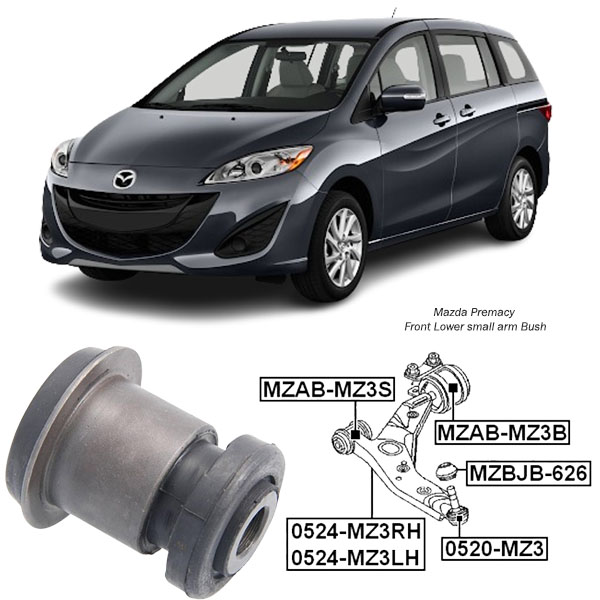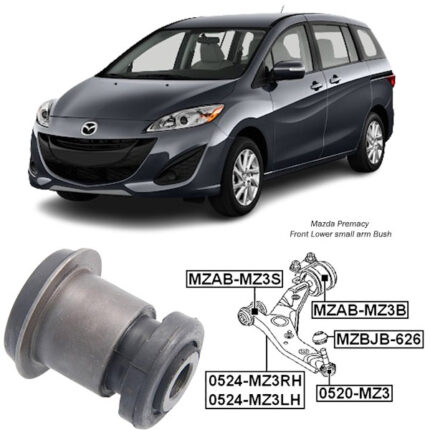Get Mazda Premacy Front Lower small arm Bush MZAB-MZ3S in Kenya
The front lower small arm bush (also known as a control arm bushing) is a crucial component in your vehicle’s suspension system. Whether you drive a Toyota Prado 120/150, Nissan Note, Wingroad, Tiida, or any other car, this small but vital part helps to maintain stability, absorb shocks, and reduce vibrations while driving.
Over time, bushings wear out, leading to issues such as clunking noises, uneven tire wear, and poor handling. This guide will help you understand how front lower small arm bushings work, their importance, signs of wear, and how to replace them.
What Is a Front Lower Small Arm Bush?
The front lower small arm bush is a rubber or polyurethane component that sits between the lower control arm and the chassis of your vehicle.
Main Functions:
Absorbs Shocks & Vibrations – Provides a smooth ride.
Reduces Metal-to-Metal Contact – Prevents excessive wear on suspension parts.
Ensures Proper Alignment – Keeps suspension geometry stable.
Improves Steering Response – Helps maintain control of the vehicle.
Without a functioning bushing, your car’s suspension will feel loose and unstable, making driving unsafe.
How Does a Front Lower Small Arm Bush Work?
The lower control arm connects the front wheel assembly to the vehicle’s chassis. The small arm bush is inserted into the control arm and acts as a pivot point for movement.
Movement Cycle:
When the car moves, the suspension flexes – The control arm moves up and down.
The small arm bush compresses and absorbs impact – Reduces stress on the metal parts.
It returns to its original shape – Ensuring stability and smooth handling.
The rubber or polyurethane material of the bushing allows it to flex without breaking, ensuring a comfortable ride and longer suspension life.
Types of Front Lower Small Arm Bushings
There are different types of control arm bushings, each offering varying performance levels:
Rubber Bushings
Standard for most vehicles
Provides a smooth and comfortable ride
Reduces noise and vibrations
Wears out faster compared to polyurethane
Polyurethane Bushings (PU)
More durable and stiffer than rubber
Improves handling and steering response
Increases road feel but may transmit more vibrations
Best for performance vehicles and off-roading
Solid or Metal Bushings
Used in racing applications
Offers maximum stability and handling
Harsh ride – not recommended for daily driving
Why Is a Front Lower Small Arm Bush Important?
Your vehicle’s stability, comfort, and handling depend heavily on the condition of the bushings. A worn-out bushing can cause:
Excessive Vibrations – Creates an uncomfortable driving experience.
Poor Steering Control – Leads to unpredictable handling.
Uneven Tire Wear – Increases maintenance costs.
Noisy Suspension – Causes knocking or clunking sounds.
Misalignment Issues – Results in drifting or pulling to one side.
A faulty small arm bush can compromise your vehicle’s safety, leading to expensive repairs if left unchecked.
Signs of a Worn-Out Front Lower Small Arm Bush
Over time, the rubber or polyurethane material deteriorates due to heat, friction, and road conditions. Here are the common signs that indicate your bushing needs replacement:
Clunking or Knocking Noise – Especially when driving over bumps.
Vibrations in the Steering Wheel – A shaky steering wheel at high speeds.
Uneven or Rapid Tire Wear – Irregular tread wear patterns.
Loose or Wandering Steering – Car drifts left or right.
Poor Handling During Turns – Feels unstable when cornering.
Excessive Play in Suspension – Delayed response when steering.
If you notice any of these issues, it’s time to inspect and replace your bushings.
How to Replace a Front Lower Small Arm Bush – Step-by-Step Guide
Replacing control arm bushings requires some tools and patience, but it’s a doable job for experienced DIYers.
Tools Needed
Jack & jack stands
Wrench set
Pry bar
Ball joint separator
Press tool or hydraulic press (for pressing out old bushings)
New front lower small arm bush
Installation Steps
Park on a Flat Surface – Engage the parking brake and secure the car.
Loosen the Lug Nuts – Before jacking up the car.
Jack Up the Front of the Car – Secure it with jack stands.
Remove the Front Wheels – To access the control arms.
Unbolt the Lower Control Arm – Disconnect it from the suspension.
Press Out the Old Bushing – Use a press tool or hydraulic press.
Install the New Bushing – Press it into place.
Reassemble Everything – Bolt the control arm back into place.
Tighten All Bolts to Spec – Use a torque wrench.
Lower the Car and Test Drive – Check for any noises or handling issues.
Tip: Always align your wheels after replacing bushings to prevent uneven tire wear.
Maintenance Tips for Long-Lasting Bushings
Follow these tips to extend the life of your front lower small arm bushings:
Inspect Bushings Every 20,000 km – Check for cracks or wear.
Lubricate Polyurethane Bushings – Reduces friction and noise.
Avoid Rough Roads – Potholes and bumps speed up wear.
Align Your Wheels Regularly – Prevents premature bushing damage.
Replace Worn-Out Bushings Immediately – Prevents damage to other suspension parts.
Regular suspension maintenance keeps your ride smooth and trouble-free.
Common Questions About Front Lower Small Arm Bushings
How long do front lower small arm bushings last?
On average, 80,000 – 150,000 km, depending on driving conditions.
Can I drive with worn-out bushings?
Yes, but it’s unsafe. Worn bushings affect handling, tire wear, and suspension stability.
How much does it cost to replace bushings?
Expect $50 – $200 for the parts, plus labor costs if done at a shop.
Do I need an alignment after replacing bushings?
Yes! Always align your wheels after bushing replacement.
Follow us on Facebook for more parts.




